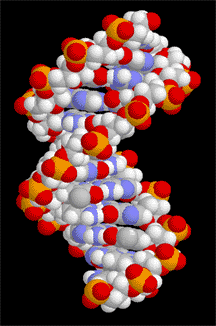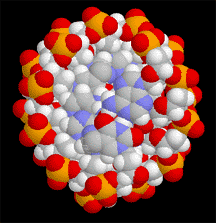Desoxyribose nucleic acid(DNA)
The main thread starts here...
and describes the structure of DNA in simple terms, avoiding chemistry
and physics as much as possible. The beautiful details and my
views on love, life, and death are found by clicking on the highlighted
links. An introduction tells why I think DNA is important. If you already know, or don't
want to read what I think about it, move on ahead.
|
|
|
|
|
|
|
The Chemical Structure of DNA
DNA is a linear polymer, which means it is a chain of units, or
monomers. The monomers of DNA are called nucleotides.
Each nucleotide contains a phosphate, a sugar, and a base. There are four nucleotide types, identical except for the base.
The bases adenine and guanine consist of two rings of atoms, while
the smaller cytosine and thymine contain only one. If you have
a browser that can run Java applets you can see the following
molecules and rotate them in space:
a nucleotide:dAMP
a nucleotide pair: A:T
A specific segment of a DNA molecule is written using the first
letters of the bases, in the 5' to 3' direction:
...TGAACGCTA...
|
|
 |
|
|
|
|
|
|
|
|
|
|
|
The Physical Structure of DNA
There is no real difference between chemical and physical structure,
but here we mean structure maintained by forces weaker than covalent
bonds. |
|
|
|
|
 |
DNA molecules in cells consists of two strands of DNA with the
phosphate backbones running in opposite directions. The two strands
are held together by the complementary hydrogen bonds of the G:C
and A:T base pairs. However, the stability of double stranded
DNA depends even more on forces that cause the planar bases to stack along the axis of the structure.
<--- bases are too far apart
The optimal separation between bases is 3.4 angstroms. However,
the distance between bases, along the phosphodiester backbone,
is about twice that distance. If DNA were a straight ladder the
bases would thus be too far apart to form a stable stack. |
|
|
|
Twist the strands into a helix and the bases come together and
form a stack --->
The solution to base separation is to twist the double stranded
structure into a helix. The distance between nucleotides along the now inclined phosphodiester
backbone stays the same but the bases are now separated along
the axis of the helix by the optimal 3.4 angstroms. At this separation
they are in contact, e.g. there is not even space enough for water
molecules to get between them. In the helix there are about 10.5
base pairs in a complete turn, or an average twist of 34 degrees
per base.
We can study the forces that hold this molecule together by causing
it to fall apart. It is easy to follow unwinding and strand separation
by measuring absorption in the u.v. It is even easier to destroy (denature) the helical structure,
just increase the temperature until it melts. |
|
|
|
|
|
|
 |
|
A 12 nucleotide long DNA molecule
|
|
|
|
|
|
|
|
|
|
| ATOM |
COLOR |
| phosphorus |
orange |
| oxygen |
red |
| carbon |
gray |
| nitrogen |
purple |
| hydrogen |
white |
|
|
|
|
|
|
 |
|
|
 |
|
|
|
TOP VIEW
The orange and red phosphodiester backbone spirals down on the
outside.
The purple nitrogen atoms mark the heterocyclic bases in the middle.
The drab gray and white sugars fill in between bases and phosphates. |
|
SIDE VIEW
The 12 nucleotide pairs make just more than one complete turn
of the helix.
The stacked bases in the middle are so close together that you
just see a sliver of black between them once and awhile.
The minor grove starts at top right and then spirals down to the
left. The major grove is seen here as a big V shaped cleft on
the right side of the helix. |
|
Typical DNA molecules are so long that they have unusual properties when purified. When inside
the cell they are folded in a complex pattern around special proteins
and become chromosomes. This important part of the DNA story will
be the subject of another essay.
Research on DNA structure has been intertwined with study of function, and little has been
said about function in this essay. However, a little history may serve as an appetizer.
Return




